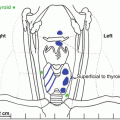Fig. 5.1
Two-site immunoassay with bridging of two antibodies with antigen (left) and heterophile antibodies bridging the two antibodies (right) independent of the antigen, resulting in an increase in the bound-labeled antibody concentration
In retrospect, it was clear that this patient did not have cancer-associated hypercalcemia, and perhaps, further testing was not needed in this regard. The positive PTHrP results should probably have been flagged as a “red herring” from the outset. The patient’s history of hypercalcemia was too long and the hypercalcemia is too mild to be consistent with cancer-associated hypercalcemia, which is usually a preterminal event (median time to death of 30 days) that is associated with rapidly progressive, severe, and symptomatic hypercalcemia [20].
Outcome
The patient was reassured that she likely had mild, uncomplicated PHPT as what was observed. One year later, she continued to have stable, mild hypercalcemia and remained asymptomatic.
Clinical Pearls/Pitfalls
The clinical and natural history of PHPT is very important when interpreting calcium biomarker laboratory results.
PTH levels in PHPT are generally above the midpoint of the healthy population reference interval.
Consider repeating PTH when the diagnosis of PHPT is unclear, especially since dynamic changes in calcium metabolism may occur in the presence of secondary contributing factors or if there is suspicion of assay interference.
Consider additional non-PTH-mediated causes of hypercalcemia when the PTH is lower than expected for a diagnosis of PHPT.
If repeat PTH measurement remains inappropriately in the lower half of the normal range despite continued hypercalcemia and other causes of hypercalcemia are not present, then serial sample dilution may be considered.
When considering malignancy-related hypercalcemia, be mindful that a positive PTHrP result only has a high positive predictive value if the pretest probability for tumor-related hypercalcemia is high, i.e., when the patient has obvious progressive cancer and a short history of severe, progressive, and symptomatic hypercalcemia.
Understand the laboratory assays you order and communicate with your laboratory if unexpected results are encountered.
Conflict of Interest
All authors state that they have no conflicts of interest.
References
1.
2.
Glendenning P, Gutteridge DH, Retallack RW, Stuckey BG, Kermode DG, Kent GN. High prevalence of normal total calcium and intact PTH in 60 patients with proven primary hyperparathyroidism: a challenge to current diagnostic criteria. Aust NZ J Med. 1998;28:173–8.
3.
4.
Glendenning P, Pullan PT, Gulland D, Edis AJ. Surgically proven primary hyperparathyroidism with a suppressed intact parathyroid hormone. Med J Aust. 1996;165:197–8.PubMed
Stay updated, free articles. Join our Telegram channel

Full access? Get Clinical Tree





